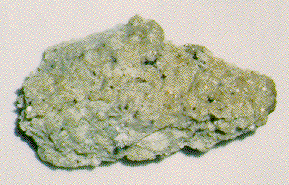chassignite

A small fragment of the Chassigny meteorite. © Ron Baalke.
Chassignite is one of the types of SNC meteorites believed to have come from Mars (see also Mars meteorites). The group is named for a meteorite that was seen to fall in Chassigny, Haute Marne, France (47° 43' N, 5° 22' E), on 3 October 1815; its subsequent recovery led to it being one of the first meteorites to be recognized as a genuine rock from space. Although it has been estimated that the Chassigny meteorite originally weighed about 4 kilograms (about 9 pounds), only about 570 grams are preserved today. A second chassignite, NWA2737, was found in the Moroccan Sahara in northwest Africa in 2000 but not recognized as a meteorite until 2004. It has a somewhat higher Mg/Fe ratio than that of Chassigny and is highly shocked.
Chassigny is mineralogically similar to a terrestrial dunite – a rock made mostly of olivine, which formed deep underground from mantle material. Chassigny is composed of about 91% iron-rich olivine with intercumulous pyroxene, feldspar, and oxides. Cracks within it are filled with various carbonates and sulfates, which suggest the rock was exposed to liquid water before its arrival on Earth. Its crystallization age of 1.36 billion years and its composition, suggest a close relationship with the nakhlites and an origin in the same parent magma on Mars. However, Chassigny contains noble gas abundances that are different from those seen in other Mars meteorites or in the present martian atmosphere. If these gases derived from the martian mantle, as suspected, Chassigny must have originated within a magma pluton deep inside the martian crust.


